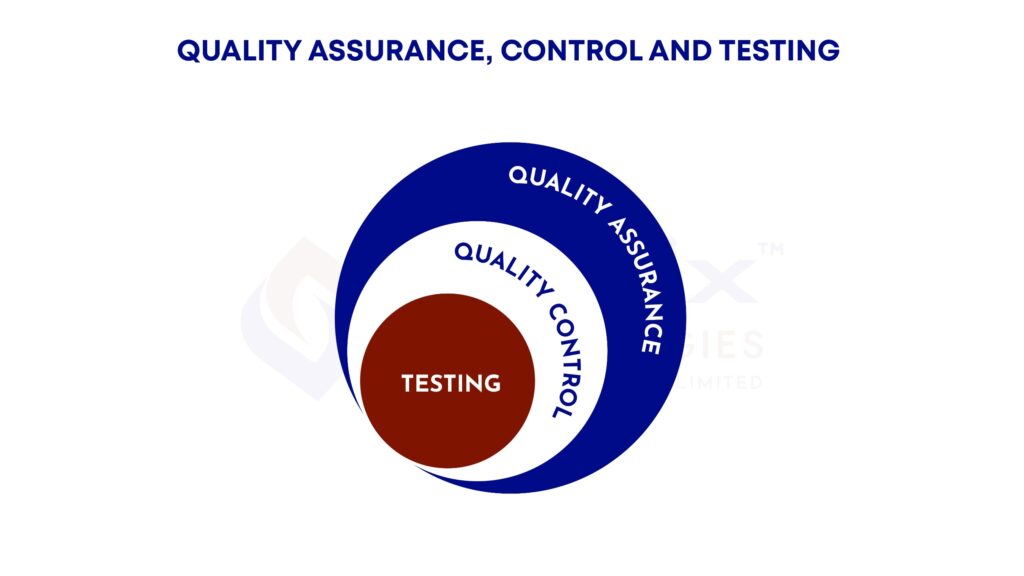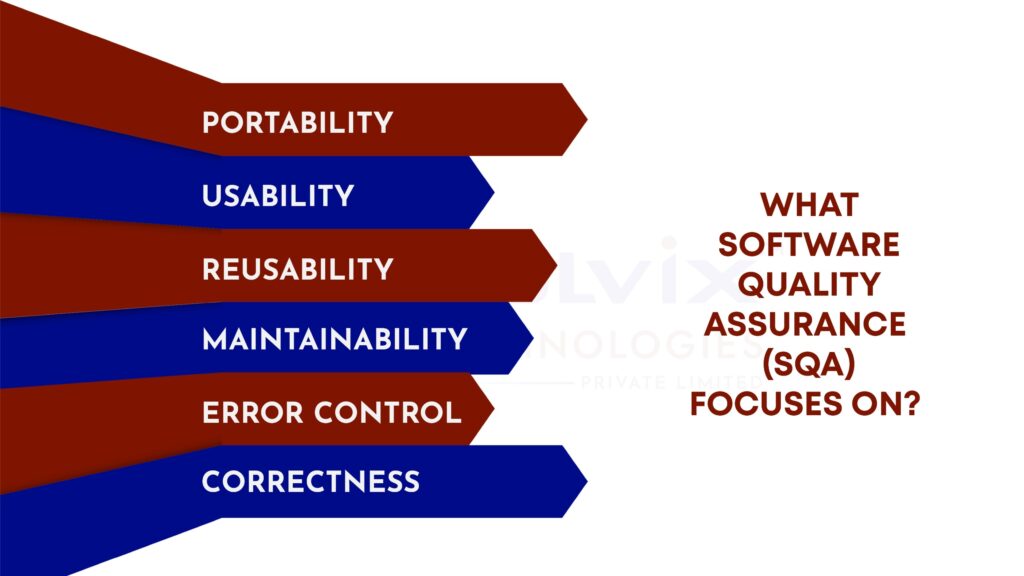No products in the cart.
Quality Assurance in Software Development: Principles, Tools & Best Practices
Quality is never an afterthought. It’s baked into every step of the software development lifecycle or at least it should be. Quality Assurance (QA) plays a vital role in ensuring that the product delivered isn’t just functional, but dependable, secure, and aligned with user expectations.
In this guide, we have explored the QA in detail, its principles, tools and best practices to implement for long term steady growth.
What Is Quality Assurance in Software Development?

At its core, Quality Assurance (QA) is a set of practices aimed at preventing defects in software products. Rather than simply “catching bugs,” QA focuses on creating processes that ensure consistent quality throughout the development cycle.
Let’s break down three commonly confused terms:
- Quality Assurance (QA): Process-focused. It’s about building the right systems and standards to prevent bugs.
- Quality Control (QC): Product-focused. Involves inspecting the final product to catch any defects before release.
- Software Testing: A subset of QA and QC. It involves executing a program to identify errors.
Put simply, QA is proactive, while QC and testing are reactive.
Why QA Isn’t Just About “Finding Bugs”
Yes, bug detection is part of the job. But QA also improves design, enhances user experience, ensures compliance, and optimizes performance. The goal isn’t just to ship something that works, it’s to ship something that works well, works fast, and keeps working under pressure.
Why QA Is Crucial in Today’s Development Ecosystem
Modern software systems are expected to scale quickly, integrate with third-party tools, and remain secure, all while meeting fast-paced delivery cycles. Here’s how quality assurance testing services contribute to this reality:
Product Reliability, Security & Performance
QA helps ensure:
- Minimal downtime
- Protection from data breaches
- Stable performance under varying loads
Business Outcomes Backed by QA
- Lower costs through early defect detection
- Shorter release cycles thanks to automated tests and streamlined pipelines
- Improved user satisfaction by catching usability issues before users do
QA in Agile and DevOps
The Agile mindset promotes collaboration and adaptability. DevOps emphasizes speed and automation. QA ties them together, ensuring fast doesn’t mean sloppy.
Types of Quality Assurance Methods

Delivering high-quality software requires more than one kind of test. Quality assurance services use a variety of methods, each with a specific focus and purpose. Here’s a deeper look into the most essential types:
Manual Testing
Manual testing involves testers manually executing test cases without any automation scripts. It’s highly effective when:
- You’re working with a new feature that lacks mature automation.
- UI/UX feedback is critical (design tweaks, layout inconsistencies, button behaviors).
- Exploratory testing is needed to simulate unpredictable user behavior.
Manual testing is also helpful for catching visual bugs, content errors, or inconsistencies that automated tools often miss.
Automation Testing
In automation testing, test cases are written as code and executed by tools like Selenium, Cypress, or Playwright. This approach:
- Increases test coverage across browsers and devices.
- Reduces human effort for repetitive tasks (e.g., checking form validation on every deployment).
- Speeds up the regression cycle in CI/CD pipelines.
However, automation isn’t meant to replace manual testing, it complements it. Automate what’s stable and repeatable. Keep exploratory and creative testing manual.
Functional Testing
Functional testing validates the software against the functional requirements or specifications. It checks whether each feature behaves as expected. Examples include:
- Login systems: Does the login page accept valid credentials and reject invalid ones?
- Checkout flows: Can users complete purchases successfully?
- Account management: Are user profile changes saved correctly?
This type of testing ensures that core user paths are fully operational from sign-up to logout.
Non-Functional Testing
Beyond functionality, software must perform well, remain secure, and deliver a smooth user experience. Non-functional testing focuses on these critical attributes:
- Performance Testing: Measures speed, response time, and system stability under load. Can your app handle 10,000 users at once?
- Security Testing: Identifies vulnerabilities like broken authentication, insecure data storage, or XSS/SQL injection risks.
- Usability Testing: Evaluates how intuitive and user-friendly the interface is. Are users getting confused or stuck?
Non-functional testing is vital in systems where performance, trust, and accessibility directly affect user retention and reputation.
Regression Testing
Every time a new feature is added or a bug is fixed, there’s a risk of breaking something else. Regression testing ensures that:
- Old features still work as expected after code changes.
- Updates don’t introduce new defects.
It’s a safeguard that helps maintain stability over time and is especially important in complex, evolving systems.
Smoke Testing
Also known as “build verification testing,” smoke testing is a quick check to ensure the most critical paths work before diving into detailed QA. It answers the question:
“Is the build stable enough to test further?”
Typical smoke tests might check:
- Application launch
- Login functionality
- Navigation between core screens
If any of these fail, there’s no point running deeper tests, the build goes back to developers for fixes.
How QA Has Evolved: Traditional vs Modern Approaches
Waterfall QA
- Testing occurs at the end
- Delays bug discovery
- Not suited for fast iteration
Agile QA
- Testing happens throughout development
- QA participates in sprint planning
- Encourages rapid feedback and fixes
DevOps & Continuous Testing
- Testing is integrated into CI/CD pipelines
- Every commit triggers tests
- Prevents bottlenecks near deployment
QAOps: QA Meets DevOps
QAOps ensures QA teams collaborate directly with ops and development, allowing:
- Real-time feedback
- Scalable test environments
- Continuous Quality Monitoring
Core Principles That Define Quality Assurance Services
A strong QA process is built on a few fundamental principles:
1. Test Early, Test Often
Identifying defects in the early stages like during planning, requirement gathering, or design is significantly less costly than addressing them later in production. Early testing also provides teams with better visibility into potential pitfalls, allowing time to course-correct before they become expensive issues.
2. Smart Test Automation
While automation is a powerful tool, it shouldn’t be applied everywhere. Prioritize automating repetitive, stable, and time-consuming test cases especially those involved in regression and integration while leaving exploratory and UI tests to manual efforts for better judgment and flexibility.
3. Fast Feedback Loops
QA should provide developers with timely, actionable insights, ideally within minutes of a build. Quick feedback shortens the development cycle, reduces context switching, and fosters faster resolution of issues, especially in continuous integration environments.
4. Traceability
Each test case should be linked to specific requirements, user stories, or business rules. This traceability not only ensures coverage but also makes it easier to track down the root cause of defects, justify testing decisions, and meet compliance or audit requirements when necessary.
5. Risk-Based Testing
Testing efforts should be aligned with business priorities and potential impact. Features that affect critical workflows, sensitive data, or high user traffic deserve deeper testing, whereas low-risk components can be tested with lighter methods, saving time without compromising overall quality.
Popular QA Tools and Frameworks
QA relies on a well-equipped toolbelt. Here’s a categorized breakdown:
a. Test Automation Tools
- Selenium: Browser automation, widely used.
- Cypress: Fast, developer-friendly, ideal for frontend.
- Playwright: Modern alternative for end-to-end browser tests.
b. CI/CD Integration Tools
- Jenkins: Open-source and extensible.
- GitHub Actions: Integrated into GitHub workflows.
- GitLab CI: Built-in pipeline tools for GitLab users.
c. Performance Testing
- JMeter: Open-source and scriptable.
- LoadRunner: Enterprise-grade performance simulation.
d. Bug Tracking & Reporting
- Jira: Powerful issue tracking and project management.
- Bugzilla: Lightweight and reliable.
- Mantis: Simple and effective for small teams.
e. Test Case Management
- TestRail: Manage, execute, and track test cases.
- Zephyr: Jira-integrated test management.
Common QA Challenges and How to Solve Them
Even the best QA teams face roadblocks. Here are a few:
Environment Configurations
Solution: Use containerization tools like Docker for consistent environments.
Unclear Requirements
Solution: Collaborate early with product and business teams. Use BDD frameworks like Cucumber for shared understanding.
Flaky Tests
Solution: Avoid hardcoded waits. Use better assertions and retries.
Scaling Automated Tests
Solution: Use parallel test execution and cloud-based test platforms.
Cross-Team Communication
Solution: Set up shared dashboards, daily stand-ups, and ensure QA is present in sprint ceremonies.
Best Practices Every Development Team Should Follow
To make QA effective, developers and testers need to align:
- Involve QA at the requirement gathering stage.
- Write modular, reusable test cases.
- Commit test scripts into version control systems.
- Prioritize test scenarios based on business risk and frequency.
- Keep all test plans and documentation up to date and accessible.
How QA can Evolve in the Future?
QA is becoming smarter and more integrated.
AI/ML in QA
- Predictive analytics to forecast high-risk areas.
- AI-generated test cases for better coverage.
Shift-Left and Shift-Right Testing
- Shift-left: Move testing earlier in the lifecycle.
- Shift-right: Focus on monitoring and testing in production.
Continuous Quality Monitoring
Tools now observe user behavior and performance metrics in real time to guide future tests.
QA for Microservices & Cloud-Native Apps
New systems demand new strategies. Container-level testing, service virtualization, and resilience checks are critical.
Conclusion
Software quality assurance isn’t a checkbox; it’s a philosophy embedded in every part of development. Whether it’s catching a subtle UI issue or stress-testing a backend API, quality assurance testing services are what stand between average software and exceptional digital experiences.
If you’re looking to strengthen your QA processes, improve testing automation, or explore dedicated quality assurance services, it’s time to connect with experts who understand both the technical side and the business impact of software quality. Contact us today.
